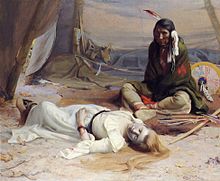eanger欧文过程(1866年9月3日–1936年4月26日)是美国艺术家和创始成员和第一任总统艺术家的Taos社会。他是著名的画土著美国人,新墨西哥,和美国西南部。他在Taos的家和工作室都保存为eanger欧文因为房子和工作室约瑟夫亨利夏普工作室,这是上市的登记簿和文化性质的新墨西哥登记。
早期的生活和教育

欧文Eanger淡然:Elk-Foot陶斯的部落
这是个(发音与“房子”押韵[1])生于一个农民家庭萨吉诺,密歇根。作为一个男孩,他开始画画的成员齐佩瓦族部落的人住在附近。他参加了当地的学校作为一个孩子,继续在艺术工作。

的历史学家e·欧文淡然,创作于1902年。
淡然离开密歇根专业艺术研究芝加哥艺术学院和国家设计学院,纽约。他去了巴黎,在那里他学习了美术学院和Academie朱利安下得胜William-Adolphe爱神。他住在法国10年来,绘画的主要景观诺曼底海岸。在1893年至1896年之间,他住在Etaples艺术殖民地,[2]他在画它的街道和渔民,包括沿海的场景,Etaples。
艺术事业在美国

这是个知足
他返回美国后,导致第一次住在纽约。他花了时间陶斯,新墨西哥州在夏天。在19世纪,西南,特别是和新墨西哥州,吸引了众多的艺术家和作家,因为它仍然没有被国家扩张的努力由美国的政策天定命运。这个时代的艺术家和作家想要捕捉最后遗留下来的老西部之前就消失了。在新墨西哥州,期间自然灾害研究和画陶斯印第安人的生活和文化,普韦布洛部落。他开始展示他的画印第安人的生活,并在1891年获得了他的第一个个展。
1911年导致当选国家设计学院.[3]他也变得活跃陶斯艺术殖民地。1915年,是个漂亮的六个创始成员之一陶斯艺术家协会,并当选为第一任总统。另一个创始成员是艺术家j·h·夏普附近的一个教堂,适应是个漂亮的房子作为工作室。后急剧建造了一个房子和工作室在陆地上。相邻的属性是共同认可为自然灾害/锋利的古迹,和保存,由自然灾害的基础。
淡然的作品中公共画廊Elk-Foot陶斯的部落[4](史密森尼美国艺术博物馆);陶斯印第安人村庄,月光[5](新墨西哥博物馆的艺术);森林营地(布鲁克林艺术博物馆);陶瓷制造商(两个红玫瑰基金会);手鼓制造商(莲属植物俱乐部,纽约);医学火灾(新泽西州蒙特克莱尔画廊);和Shapanagons齐佩瓦族首席(底特律艺术博物馆).[3]
这些作品,Elk-Foot陶斯的部落画在1909年的夏天,被认为是自然的杰作。这幅画是购买美国国家艺术收藏的著名的艺术品收藏家威廉·t·埃文斯现在显示的集合史密森尼美国艺术博物馆。Elk-foot的英国名字是杰瑞Mirabal,在1907年开始摆姿势没问题,是画家最喜欢的科目,因为他的“外在美和理想特性。”[6]
早期作品

从1891年俘虏,一个有争议的工作。
淡然的俘虏了1891年,他的第一个个展,举行的波特兰艺术协会在俄勒冈州,然后在1892年的巴黎沙龙。这个大,”沙龙大小“绘画是第一个原住民主题的淡然,后来在美国名气的画作原住民新墨西哥。1991年,俘虏被包含在美国艺术博物馆展览《西方美国,这引起了争议的馆长解释艺术家的含义和意图。艺术历史学家探索绘画的种族、性、社会动机在美国社会的背景下。[7]
1899年,是个漂亮的三幅画在展出波士顿艺术俱乐部:印度的小马(石油)、孕妇(油),雅吉瓦人营地(石油)。当时,当然给他的地址作为范戴克工作室,第八大街939号,纽约。[需要引证]
后来的作品

Kachina画家(1917)
修补战争阀盖
制作陶器(授予500美元国家设计学院卡内基奖)
烤玉米(1904)
冲水(1912)
《暮光之城》,陶斯普韦布洛(1913)
陶斯峡谷营
陶斯印第安人村庄——月光(1914)[8]
Kachina画家(1917)
遗产和荣誉
他的作品赢得了这些机构的认可和众多奖项如下:巴黎沙龙,芝加哥艺术学院,国家设计学院(奥特曼奖,1916);和大杂烩俱乐部(依奖,1917)。他被授予的Lippincott奖宾西法尼亚美术学院(1921)。他收到了来自美国博览会颁奖,水牛;波士顿艺术俱乐部,柯康美术馆,巴拿马太平洋国际博览会在旧金山(银牌,1915)。他的作品在许多博物馆在美国和世界各地。
两栋建筑作为工作室的一部分Eanger欧文是个漂亮的房子和Studio-Joseph亨利锋利的工作室上市的国家史迹名录”,和新墨西哥的文化属性.[9]这30个网站之一被认为是一个“历史性的艺术家的家里和工作室副网站”的国家历史建筑保护信托会.[9]2001年自然基金会成立恢复和保护性能。它是两位艺术家的历史遗址和提供安排参观。
Early life and education
Couse (pronounced to rhyme with "house"[1]) was born to a farming family inSaginaw,Michigan. As a boy, he started drawing members of theChippewatribe who lived nearby. He attended local schools as a child and continued to work at art.
Couse left Michigan for professional art studies at theArt Institute of Chicagoand theNational Academy of Design,New York. He went toParis, where he studied at theÉcole des Beaux-ArtsandAcadémie JulianunderWilliam-Adolphe Bouguereau. He lived inFrancefor 10 years, painting mostly landscapes of theNormandycoast. Between 1893 and 1896, he lived at theEtaples art colony,[2]where he painted its streets and fisher folk, includingCoastal Scene, Etaples.
Artistic career in the United States
After his return to the United States, Couse first lived in New York. He spent time inTaos, New Mexicoduring the summers. At the turn of the 19th century, the Southwest, and New Mexico in particular, attracted numerous artists and writers because it remained untouched by national expansion efforts dictated by the American policy ofManifest Destiny. The artists and writers of this era wanted to capture the last vestiges of the Old West before it disappeared altogether. During his time in New Mexico, Couse studied and painted the lives and culture of the Taos Indians, aPueblotribe. He began to show his paintings of Native American life and earned his first solo show in 1891.
In 1911 Couse was elected to theNational Academy of Design.[3]He also became active in theTaos art colony. In 1915, Couse was one of the six founding members of theTaos Society of Artists, and was elected first president. Another founding member was the artistJ. H. Sharp, who adapted a chapel near Couse's house as a studio. Later Sharp built a combined house and studio on the land. The adjacent properties are recognized jointly as the Couse/Sharp Historic Site, and are preserved and operated by the Couse Foundation.
Among Couse's works in public galleries areElk-Foot of the Taos Tribe[4](Smithsonian American Art Museum);Taos Pueblo - Moonlight[5](New Mexico Museum of Art);The Forest Camp(Brooklyn Museum of Art);The Pottery Maker(Two Red Roses Foundation);The Tom-Tom Maker(Lotos Club, New York);Medicine Fires(Montclair Gallery, New Jersey); andShapanagons, a Chippewa Chief(Detroit Museum of Art).[3]
Of these works,Elk-Foot of the Taos Tribe, painted in the summer of 1909, is considered Couse's masterwork. The painting was purchased for the United States national art collection by the well-known art collectorWilliam T. Evansand is now displayed in the collections of theSmithsonian American Art Museum. Elk-foot, whose anglicized name was Jerry Mirabal, began posing for Couse in 1907 and was one of the painters favorite subjects because of his "physical beauty and ideal features."[6]
Early works
Couse'sThe Captivewas shown in 1891 at his first solo exhibition, held at thePortland Art Associationin Oregon, and then at the Paris Salon of 1892. This large, "salon size" painting was the first Native American subject by Couse, who later achieved fame in the United States for his paintings of theindigenous peoplesof New Mexico. In 1991,The Captivewas included in theNational Museum of American Artexhibition entitledThe West as America,which created controversy by its curatorial interpretation of the artists' meanings and intents. Art historians have explored the painting's racial, sexual, and social motives in the context of American society at the time.[7]
In 1899, Couse exhibited three paintings at theBoston Art Club:A Cayuse Indian(oil),Maternity(oil), andYakima Encampment(oil). At the time, Course gave his address as the Van Dyck Studios, 939 8th Avenue, New York City.[citation needed]
Later works
Mending the War Bonnet
Making Pottery(awarded $500 National Academy of DesignCarnegie Prize)
Roasting Corn(1904)
Rushing Water(1912)
Twilight, Taos Pueblo(1913)
Taos Canyon Camp
Taos Pueblo - Moonlight(1914)[8]
The Kachina Painter(1917)
Legacy and honors
His works won recognition and numerous awards from such institutions as the following: theParis Salon, theArt Institute of Chicago, the National Academy of Design (Altman prize, 1916); and theSalmagundi Club(Isidor prize, 1917). He was awarded the Lippincott prize from thePennsylvania Academy of Fine Arts(1921). He received awards from the American Exposition, Buffalo; theBoston Art Club, theCorcoran Gallery, and thePanama Pacific International Expositionin San Francisco (silver medal, 1915). His works are held in many museums in the United States and around the world.
Two buildings he used as studios are part of theEanger Irving Couse House and Studio—Joseph Henry Sharp Studioslisted on theNational Register of Historic Placesand theNew Mexico Register of Cultural Properties.[9]This is one of 30 sites recognized as an "Historic Artist's Home and Studio Associate Site" by theNational Trust for Historic Preservation.[9]In 2001 the Couse Foundation was formed to restore and preserve the properties. It operates the historic site of the two artists and offers scheduled tours.
1、本站美术网信息均来自于美术家自己或其朋友、网络等方式,本站无法确定每条信息或事件的真伪,仅做浏览者参考。
2、只要用户使用本站则意味着该用户以同意《本站注册及使用协议》,否则请勿使用本站任何服务。
3、信息删除不收任何费用,VIP会员修改信息终身免费(VIP会员点此了解)。
4、未经本站书面同意,请勿转载本站信息,谢谢配合!